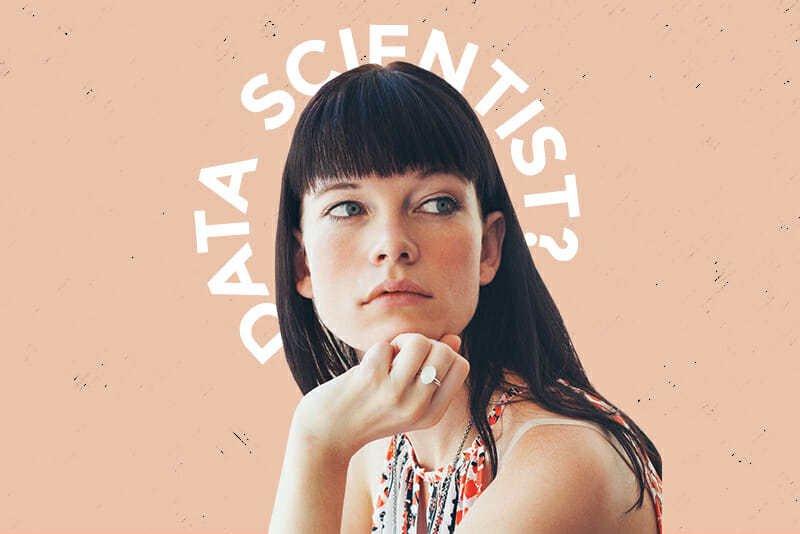How to Become a Data Scientist: What You Need to Know

There’s no doubt that having a data scientist job means you’re on a promising career path—one that’s in-demand, fulfilling, and highly lucrative. In fact, Harvard Business Review even dubbed data scientist the sexiest job of the 21st century!
But what does a data scientist do? And what do you have to do to land a data scientist position?
If you’re ready to learn how to become a data scientist, then keep reading! I’ll break down exactly how to make the jump to this dream career.
What Does a Data Scientist Do?
Before I go over how to become a data scientist, I want to make sure you have a clear picture of what a data scientist’s role looks like. Data scientists are mid- to senior-level employees who are responsible for organizing and analyzing large amounts of data. They then interpret their findings to create predictions and determine actionable steps for businesses to achieve their goals. And they earn a huge paycheck in the process—as of this article the current average salary for data scientists is $122,359.
If you’re picturing a data scientist alone behind a computer screen all day, that’s not actually accurate. Yes, data scientists must be very analytical (say hello to complex quantitative algorithms!). And yes, they must be intuitive and have the ability to problem-solve. But data scientists must also be quite collaborative and excellent communicators so they can translate their technical findings to non-technical teams.
As Data Governance Specialist Alyssa Columbus says in this Forbes article, “the true impact of a data scientist’s work depends on how well others can understand their insights to take further action and make informed decisions.”
What Does a Data Scientist Job Description Look Like?
A data scientist job description can vary greatly depending on the needs of the company hiring. According to this Harvard Business Review article, the title data scientist covers a wide range of work, “including the massive online experimental frameworks for product development at booking.com and Etsy, the methods Buzzfeed uses to implement a multi-armed bandit solution for headline optimization, and the impact machine learning has on business decisions at Airbnb.”
In terms of responsibilities, that means data scientists may find themselves:
- Collecting and cleaning large quantities of data from company databases
- Constantly assessing the effectiveness of data collection methods and improving on these methods
- Developing and applying statistical modeling, machine learning, and algorithms to mine data
- Analyzing the data so it can be used to solve problems and identify opportunities
- Using predictive modeling to find trends and patterns that can be used to improve customer experiences and other business outcomes to increase revenue
- Clearly communicating findings to executives and other key stakeholders
What Skills Do Data Scientists Need and How Do You Get Them?
If you’re wondering how to become a data scientist, you’ll also need to know which skills to learn. The most in-demand skills are:
- Programming languages (Python, R)
- Query languages (SQL, Hive, Pig)
- NoSQL databases (MongoDB, Cassandra, HBase)
- Big data processing frameworks (Hadoop, Spark)
- Data visualization tools (D3.js, GGplot)
- Machine learning techniques (regression, decision trees)
- Applied statistics (distributions, statistical testing, regression)
- Excellent business acumen and strong communication skills, as mentioned above
In order to master the technical skills, you have quite a few options. You can always go back to school and get a Master’s or Ph.D. in mathematics, statistics, or computer science. But what if you don’t have the time or resources to enroll in such a program? In that case, a data scientist bootcamp may be a good option.
A data scientist bootcamp is an intensive, immersive program that lasts around 3-6 months. After completion, a student will have a portfolio of completed work and should feel ready to apply for an entry-level data scientist position.
Some data scientist bootcamp options include BrainStation, Flatiron School, and General Assembly, which all offer full-time, part-time, and online options. Before enrolling, you may need to have some foundational skills under your belt, including applied mathematics and statistics, so be sure to be aware of these requirements when determining which bootcamp is right for you.
If you’re not ready to fully jump into a bootcamp program, you can also start by focusing on learning one or two skills to get you started. For instance, you can begin building up your skills by taking our self-paced Python for Web Apps & Data course. Python is an extremely versatile programming language, so if you end up realizing data science isn’t for you, Python is still a marketable skill to have on your resume!
How to Land a Data Scientist Job
Once you have the data scientist skills you’ll need, it’s time to land a data scientist job! What are the best ways to prepare and find the right position for you? Let’s take a look.
Network With the Data Scientist Community
Networking is a powerful way to make real, face-to-face connections with other data scientists, and it’s something that can be done even before you’re ready to start job hunting. You can use sites like Meetup.com to find data scientist events in your area. Or you can attend a data scientist conference like the Strata Conference or the Knowledge Discovery in Data Science Conference (KDD).
The earlier you start making connections, the easier time you’ll have when you’re ready to find a data scientist job.
Apply for Data Scientist Jobs
Once you have the skills and portfolio to prove it, start applying for jobs and preparing for interviews! The usual suspects like Glassdoor and Indeed are always good job boards, but you can also look at Data Elixir, DataJobs, or the Data Analytics Association, which are job sites specifically geared toward data science-related jobs. Working with a recruiter who specializes in data science is also something to keep in mind.
And if you’re having feelings of self-doubt or imposter syndrome, know that it’s completely normal to feel that way! Like Columbus says, “If you don’t meet all of a job’s requirements, apply anyway. You don’t have to know every skill (e.g., programming languages) on a job description, especially if there are more than ten listed. If you’re a great fit for the main requirements of the job’s description, you need to apply.”
It’s also helpful to treat each application and interview as a learning process. You’ll get a better idea of which skills employers are truly looking for each time you apply and/or interview. And if you’re lacking any of them, you’ll know what to focus on to be better qualified for the next job you apply for.
Hopefully you now have more clarity on how to become a data scientist. Making the transition will take serious effort, but the payoffs can be huge: a satisfying career in a growing field and an impressive paycheck to go along with it!




